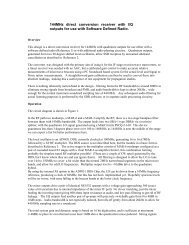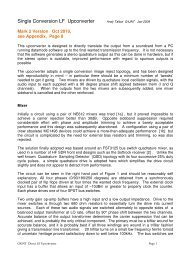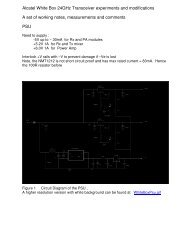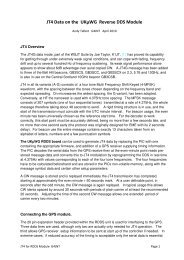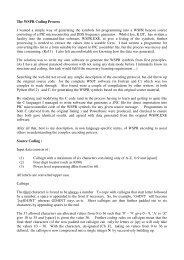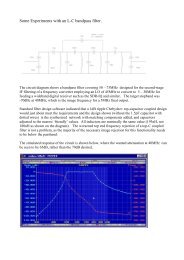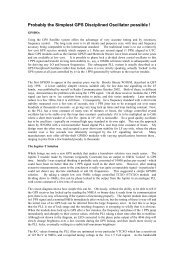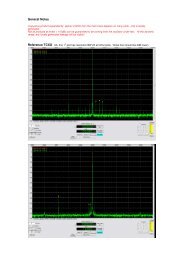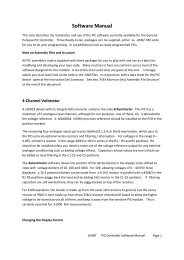NEW GENERATION BEACON DRIVER - G4JNT
NEW GENERATION BEACON DRIVER - G4JNT
NEW GENERATION BEACON DRIVER - G4JNT
Create successful ePaper yourself
Turn your PDF publications into a flip-book with our unique Google optimized e-Paper software.
The Green LED gives a short flash once per second while carrier-only is being transmitted.The Red LED flashes in sympathy with the CW characters when CW is being sentAlternate Red/Green flashes for the BPSK mode, once per second corresponding to each phase stateWhen lockup has been achieved and the beacon is operating normally :The Green LED gives a long flash once per second while carrier-only is being transmitted.The Red LED flashes in sympathy with the CW characters when CW is being transmitted.Alternate Red/Green flashes for the BPSK mode, once per second corresponding to each phase stateFor the JT65 transmission, the LED flashes Red at the JT65 symbol rate of 2.7Hz---------------------------------------------------------------------------------------------------------------------------Frequency Doubler and Output Buffer.At the 204.8MHz clock frequency of the DDS chip, the maximum frequency that can be generated by the AD9852 chip isaround 80MHz. A 5 th order elliptic filter on the PIC output, mounted on the DDS board, reduces alias and harmonicproducts to at least 50dBc A frequency doubler built in a separate module is used to generate the final 144MHz output,The output from the DDS board is amplified to a level of approximately 11dBm and feeds a push-pull diode doublercircuit. This provides 40dB rejection of the fundamental and is followed by a two section bandpass filter that ensures allspurii are at a level of at least 55 dBc. Two stages of amplification raise the filter output to a level of 12.5dBm with thefinal modamp running at 1 - 2dB of gain compression. The buffer has no harmonic filtering on its output so if the doubleris to be followed by broadband amplification, extra harmonic filtering will be needed.All amplifier stages consist of MAR-3 and MAR-4 modamps supplied from constant current regulators to give immunityfrom supply voltage and temperature variations. Any supply voltage from 9 to 13V is acceptable. The doubler / bufferassembly is constructed in a screened tinplate box with SMC connectors for the RF, and a feedthrough capacitor for thesupply voltage.---------------------------------------------------------------------------------------------------------------------------User ProgrammingFrequency information (the codes that need to be sent to the DDS chip) together with the text of the various messages arestored in the EEProm memory area of the PIC. The boundaries of the various messages need to be known by theassembler, so it is not possible to reprogramme the EEProm contents alone if the length of any of the messages have beenchanged. In general it is safer to re-assemble the whole file and re-programme the entire PIC device – this should take lessthan one minute for most PIC programmers. Any change to the message sequence, or time slot allocation, must involve acomplete re-programming of the PIC.Frequency and message contents are contained in a separate include file (VHFBCNE2.INC) which can be edited on its own.A total of 128 bytes of storage is available, and of this the first 30 bytes are used for frequency data, leaving 98 bytes forstorage of all the characters needed for all the messages.The frequency information (DDS codes) can conveniently be generated from an accessory programme calledVHFBCNCALCS.EXE. See Annex A for an example of this utility. The programme generates a file which includes linesof PIC code that can be directly cut and pasted into VHFBCNE2.INC. See the example below. The include file also hasother constants used within the programme, such as RPTTime - the number of minutes (pairs of time slots) for thetransmission sequence; CWSPEED (the CW dot length in milliseconds) for the CW messages; and the RTTY baud ratedefined in units of 500µs. It is convenient to let the assembler calculate this value for you, by dividing 2000 by a specifiedbaud rate. The constant NMEAPol, shown in the example, is not applicable to this software, but is needed in other PICsoftware that makes use of the same include file.Note that the DDS controller software here does not make use of the carrier frequency itself. Instead, the following valuesare stored in EEProm to produce the required frequencies from the specified clock:The absolute JT65 Sync frequencyThe increment between tonesGenerates a tone of 11025 / 1024 * 118 ≈ 1270.5Hz in an SSBreceiver tuned to the specified carrier frequency.11025/4086 * M where M is 1 for JT65A, 2 for JT65B and 4 forJT65C. For JT65B the increment is approximately 5.38Hz The PICsoftware then calculates the frequency data to be sent to the DDS bymultiplying this value of increment by a number between 2 and 65Page 4


